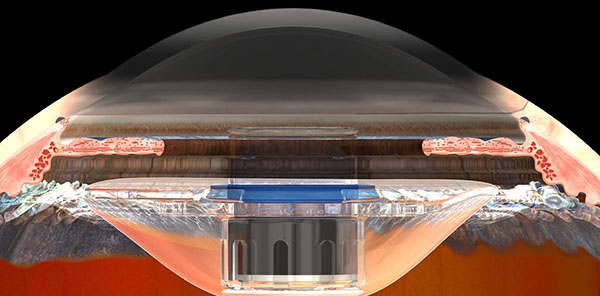1:30min

Telescope implant construction Image: CentraSight
______________________________
By Helen Carter
Journalist
Telescope implant for AMD
The FDA has approved a clinical study to evaluate the safety and effectiveness of a telescope implant called CentraSight in post-cataract surgery patients with AMD.
The implant, made by VisionCare, aims to improve visual acuity and quality of life for patients with end-stage macular degeneration whose sight is permanently obstructed by a blind spot in their central vision in both eyes.
The trial will evaluate the device’s safety and effectiveness in patients previously implanted with an intraocular lens. Hundreds of AMD patients have received the implant during the past eight years but the study will provide information about safety, effectiveness and the appropriate surgical technique for implanting the telescope in patients who have also had cataract surgery.
Eyes on rural health
Eye health will be on the program at the National Rural Health Conference in Cairns on 26-29 April.
Convenor of Optometry Australia’s Rural Optometry Group Dr Philip Anderton will chair a concurrent session on 28 April on eye health.
Speakers will include Dr Genevieve Napper talking about successful community eye health outcomes in The Victorian Aboriginal Spectacles Subsidy Scheme, Shaun Tatipata whose topic is processes supporting regional eye-care collaboration, and Uma Jatkar who will speak on closing the gap and advancing eye health across diverse regions and systems.
Early registration at a discounted rate ends on 31 January. Exhibition and sponsorship opportunities are available.
Vision checks for concussed children
A comprehensive vision assessment should be considered for children who have been concussed, to help determine when they are ready to return to the classroom, new research suggests.
The study showed that vision problems were commonly reported in children after concussion and were independently associated with those reporting academic difficulty.
It found that 46 per cent of children who reported three or more concussion symptoms for longer than 10 days had vision abnormalities including blurred vision, poor convergence or co-ordinated eye movement, and poor near sighted adjustment.
University of Alabama School of Optometry Associate Professor Mark Swanson said traumatic brain injuries could cause difficulties with near focus and the ability to co-ordinate eye movements, which could lead to blurred vision and discomfort but because these problems were related to near vision, distance visual acuity testing may not show problems with desk work.
Eye care at diabetes expo
Diabetes Expo 2017 will be held in Melbourne on 25 February for members of the public.
OPSM professional services manager Melissa Downing will speak about diabetes and eye health to the pharmacist and GP lecture stream. Vision 2020’s Vision Initiative will be exhibiting at the event.
The expo, organised by Diabetes Victoria at the Melbourne Convention and Exhibition Centre, will deliver the latest health advice on how to manage and prevent diabetes, and showcase the latest products and services for people with diabetes.
Product samples, show-bags and cooking demonstrations are included in the entry price but Diabetes Victoria members can attend free of charge.
Blinking prompts eye muscle realignment
Blinking steadies our gaze and helps our eye muscles realign, new research shows.
A team of scientists from the USA, Singapore and Paris found that when we blink, our brain repositions our eyeballs so we can stay focused on what we are viewing.
‘When our eyeballs roll back in their sockets during a blink, they don’t always return to the same spot when we reopen our eyes. This misalignment prompts the brain to activate the eye muscles to realign our vision,’ lead author Assistant Professor Gerrit Maus said in a media release.
‘Our findings suggest that the brain gauges the difference in what we see before and after a blink, and commands the eye muscles to make the needed corrections.’
Without this oculomotor mechanism, our surroundings would appear shadowy, erratic and jittery.
Corneal grant for Asia
The fourth round of the Asia Cornea Society – Santen Asia Educational Grant will provide funding support to young, aspiring corneal clinicians or corneal clinician scientists.
Funds will enable regional corneal observership at top ophthalmic institutions in Asia. The society alleviates corneal blindness in Asia.
Applications close 1 March.
New MD appointed at World Council of Optometry
The World Council of Optometry has appointed Susan Chiles as managing director.
Ms Chiles was previously the marketing communications manager in the Affiliate Relations and Membership Group at the American Optometric Association. She has worked at the AOA for the past six years.